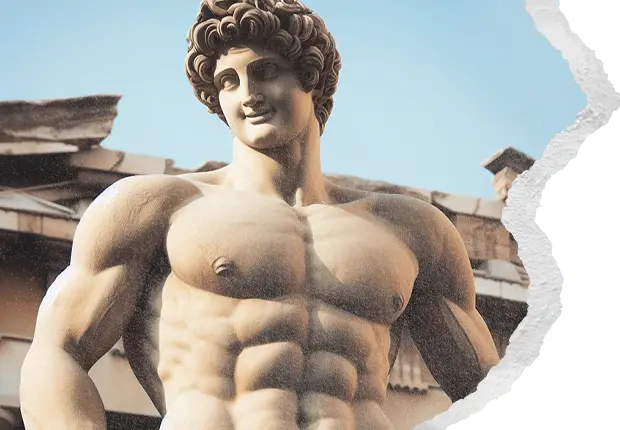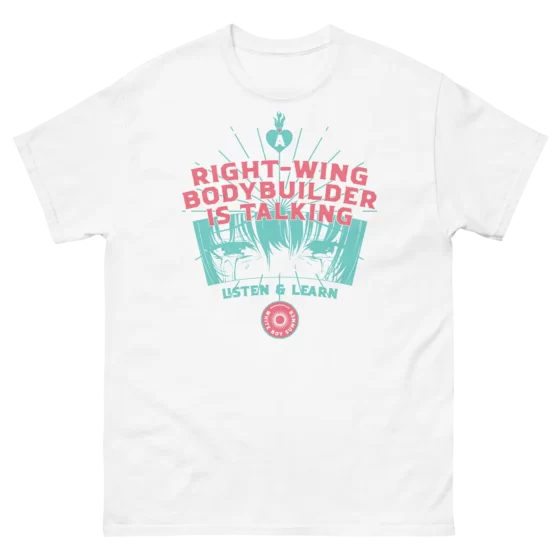Try These Five WEIRD Tricks To Get an Ancient Greek Body
The crowd goes mad. You’ve seen them excited before, but never like this. Six-time wrestling champion at Olympia, it’s unheard of, it’s legendary. The attendants walk out your prize onto the contest grounds: a four-year-old bull. How much does it weigh? Probably as much as five or six warriors?
The best men of Greece are all gathered here to see you. They are watching you, cheering for you, envying you. You feel their mad energy coursing through your veins, transporting you. Let’s give them a story to take home. Better yet, let’s brand an image in their mind. You pat the bull on the head and smile and wave.
Then the crowd goes silent as they see what you’re doing. Cries of horror. Shock and awe. No. No. Not that. Old men are covering their faces with their robes. It’s horrible. Then they all erupt. The young men are shrieking, fingernails tearing at their cheeks. Their robes are falling off their bodies as they jump up, spin around, and cackle with frenzy. He did it. The bull is on your shoulders. You’re not done. You take lap around the arena just like that.
You put the bull down and lead him to the altar of Zeus. Time to eat.
—
How do we become more like Milo of Croton, ancient Greece’s greatest Olympic wrestler? Here are some handy life hacks from Ancient Life Coach.
Trick #1: Always Begin with the Gods
Through the power of Apollo, god of rational illusion, we envision the body we yearn to sculpt into being. We dwell upon it, seek it out in images. We surround ourselves with these images, we place them in holy places. Apollo himself has a fizeek. Its likenesses dwell in his temples, among the holy things; they honor the god. The holy fizeek rises above the ephemeral clutter of malformed votive trinkets. But it derives its perennial status as an object of art not from some magical power, but rather through the superiority of craftsmanship – of discipline – which brought it into being.
“It was in dreams that the great sculptor first saw the delightful bodies of superhuman beings.”
-Nietzsche
Through the power of Dionysus, we unleash the primal instincts. We finally behold the vast potential within us, the telos of a billion year process. This effect is intoxicating. We identify the true self with this very infinite potential. We recognize the will to beauty and the will to power and find that they are one. Where Apollo has given us the method, the plan, the craft, Dionysus gives us the drive.
To use this drive full is to draw into ourselves every drop of the power of our species, in order to express it as a supreme version of our individuality. As Nietzche puts it, through Dionysus man transforms from artist into a work of art himself. This working of life into art – which begins – only begins! – with the body, is our mightiest protest against the vegetative nihilism we are ever in danger of dissolving into.
Trick #2: Focus on the Cow.
When asked how he pulled off his famous bull hoist stunt at the Olympic games, Milo of Croton explained. First of all, he was famous for eating a lot of beef. The cow is the largest and strongest food animal. Need he say more? They said he ate 20 lbs of beef per day. Also, 20 lbs of bread and 3 pitchers of wine – but remember, gentelemen, that humans were more resistant to noxious substances back then.
Second is the training aspect. Milo explained how, on top of his eating diet, and his daily callisthenics and wrestling practice at the gymnasium, he started carring a young calf when it was small. Every day it got a little bigger, and, as he kept carrying it, so did Milo.
A well-fed young bull in those days grew maybe a pound a day. The Greeks, therefore, discovered the magic of incremental increases in training: it’s nature’s way. Remember this next time you are at the weight room, and are feeling like going a little light. Next week the cow will be 7 pounds heavier.
Also, when the calf got big enough, he ate it too.
Trick #3: Become the Bull
The spiritual goal of all this bull eating is plain enough. Consider King Agamemnon:
…Powerful Agamemnon,
with eyes and head like Zeus who delights in thunder,
like Ares for girth and with the wide chest of Poseidon;
like some ox of the herd pre-eminent among the others,
A bull, who stands conspicuous in the huddling cattle;
such was the son of Atreus as Zeus made him that day
conspicuous among men, and foremost among the fighters. (Homer, Iliad book 2)
The bull is a kingly animal. It is a kingly prize – the king’s to distribute: the Mycenean anax, lord of the palace, is the one who selects the best cut of beef, and sends it down the table to the best warrior. It is also kingly to take bulls from other kings, as in the routine raids of a Homeric pirate hero, or like the sea lords in the Minoan frescoes.
But the king also resembles a bull himself, as Agamemnon does, surveying his harem, fighting the wolves off from the weak, peering around to guard against challengers. He models himself after the bull. The bull is the ideal in more than one way.
“Who is the happiest man in the world?” King Croesus asked Solon, the Athenian lawgiver. Solon thought of a few examples. The second was a pair of youths – Cleobis and Biton. Do you know the true meaning of their story?
Cleobis and Biton were young men of Argos. They were prize fighters, and very good looking. Their mother was getting ready for the festival of Hera, the most important goddess at Argos. But the Argive Heraion, the temple, where the festival takes place, is maybe six miles away from Argos, and it’s all uphill. She was planning to take her ox-cart, but the oxen were busy or something and she didn’t know what to do.
And so, to spare their noble mother the moderate embarrassment of showing up late, Cleobis and Biton cheerfully took the yokes on their own shoulders and pulled her all the way. Probably the cart was heavy also, because it was loaded with the usual cakes and fruit platters and votive statues.
You may know the end: they pull her up to the event just in time, everyone praises the mother for having such amazing sons – who still have juice to party all night, and so they do. The youths finally go to sleep in the temple, and never wake up.
They get eternal glory for this, of course. Wait, for what? For casually proving themselves equal in strength to bulls. And then dying beautifully before they have a chance to disappoint anyone. (The Argives made statues of them and stood them at Delphi.)
The bull is a leader. The very fact of resembling one may cause men to look up to you, so be ready for that, too. The philosopher Pythagoras came to town, begging the Crotoniates to help the Sybarites defeat a tyrant who just took over their city. Croton agreed – and when they went to war, Milo led the charge. He crashed his awesome bovine mass into the enemy battle lines, and rolled them up like a carpet.
Trick #4: Train Naked
Some of you may have to get creative here. But consider: the Greeks really did train naked. Surely you’ve seen the pictures on the pots. Balls in the wind – and yes, in the Sun, too. Believe it.
The Greek word for “athletics” is gymnastikē (γυμναστική). It means “things done while naked” gymnos (γυμνός) = naked. The “gymnasium” is the Nudatorium. Look it up.
This was really just a man thing. Young Spartan women did train in skimpy clothes, though.
Naked is honest. Hiding man tits with a loose shirt? Not anymore. Giant penis-shaped birthmark on your back? Everyone knows it now. But then, as a friend who was just publicly shamed once confided to me: having all your private affairs exposed is remarkably freeing. And, with everything exposed, it becomes easier to discern between things to accept and things you need to change – everyone has natural flaws, but not everyone has a flat tire around their waste.
Conversely, the truly fit man stands out in a Greek style gymnasium. He raises the bar even higher, without saying a word.
Good luck convincing your buddies to work out naked with you. Really, good luck – it would be interesting if anyone did, so let us know if you have any success – no homo.
Live straightforward, train naked. No secrets. Except, of course, your real name.
Trick #5: Begin with the End in Mind
Not everyone wants to match the stats of Milo of Croton (or Andre the Giant).
The famous Spartan youth training program, the Agoge, was more geared toward endurance training and military skills. In the ancient Olympics, the most overall military-skills-maxing event was the pentathlon. Sprint, javelin, discus, long jump, wrestling. All pretty self-explanatory in ancient warfare. Discus is a bit of a head-scratcher, until you imagine a trained Spartan spin-throwing an 8 lb river rounded stone at your head. (Or maybe it was some archaic shield-chucking game).
Spartans did well in the pentathlon. You can go to Olympia now and see the “dumbbells” Akmatidas used to make Sparta proud (they used these little things in the long jump event, not for strength training). Pentathlons make for good soldiers: Akmatidas may well have been one of The Three Hundred at Thermopylae. The dates match up well. (For more on the Spartan ways, listen to my Cost of Glory podcast series on Plutarch’s Life of Lysander).
The Greeks knew, however, that pentathlon training doesn’t make men into grandmaster wrestlers, let alone bulls. Philopoemen (Polybius’ mentor) was encouraged to take up wrestling as an athletic sport by his friends, because he was good at it. But he asked the battle trainers if focusing on athletics would train him for war. Their response? No, not if you’re serious about war. And Philopoemen was.
In some ages the need to train for warfare may be so pressing that it overwhelms the imperative to cultivate a heroic looking body. You will have to judge what sort of time you live in, and what sort of telos (end) your physique will serve.
But even if your fate is short and your end is near, from the Greek perspective, you should feel all the more intensely the drive to project beauty and excellence into the world. Milo of Croton, so the story goes, was walking through the forest, and he saw a half-split tree trunk. He felt it was an opportunity to test his strength, and so he tried to finish the job with his bare hands. His hands got stuck, and he couldn’t escape. Then a pack of wolves came upon him and devoured him.
Tragic, yes. But kind of beautiful. Do you think Milo would have trained any less hard if he knew the end was nigh? Of course not.
To your health.
































